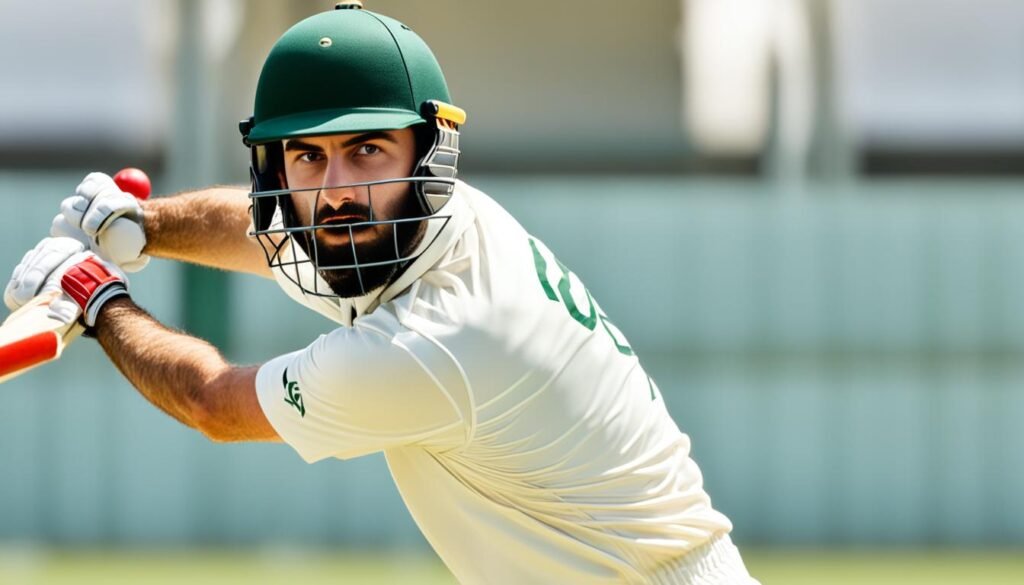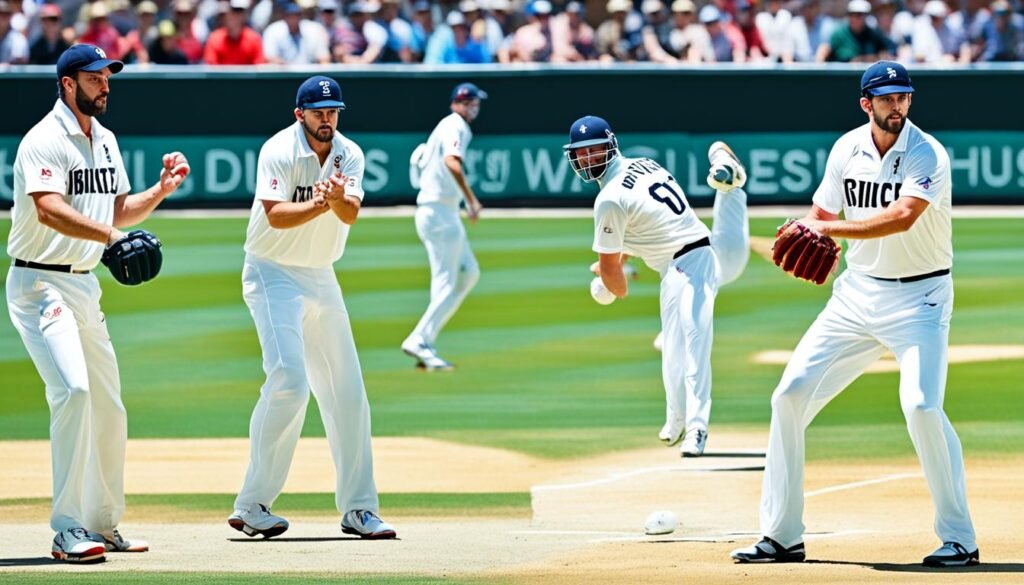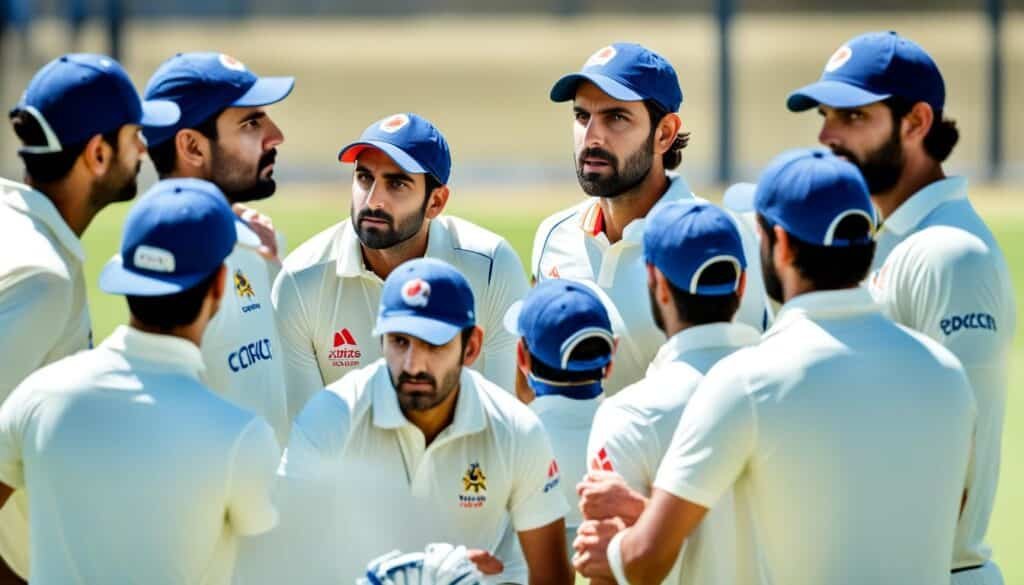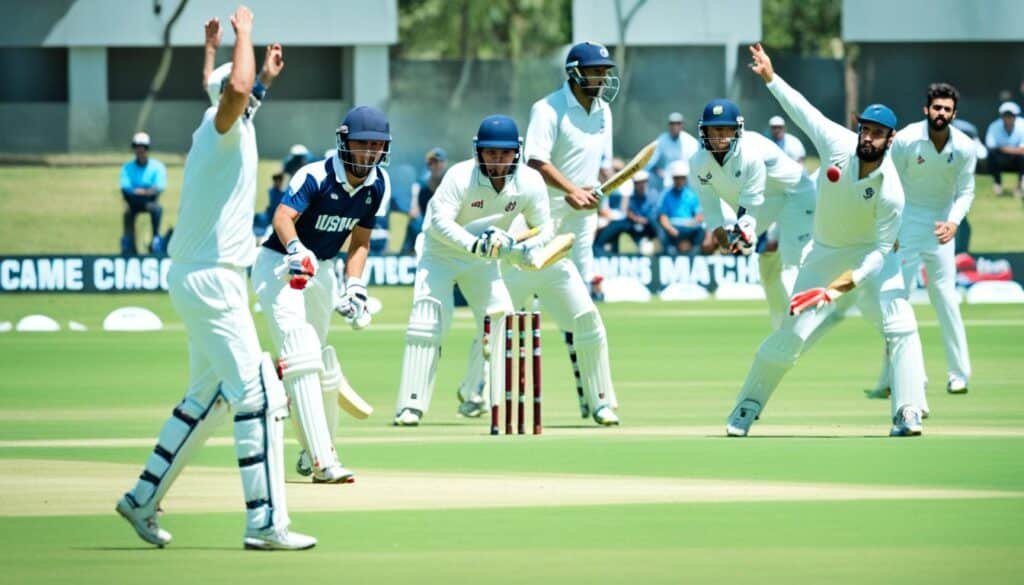A Beginner’s Guide To Cricket Strategy : Welcome to our beginner’s guide to cricket strategy! In this article, we will explore the world of cricket strategy, providing you with a comprehensive understanding of the game’s tactics and techniques. Whether you’re new to cricket or looking to improve your skills, learning cricket strategy is essential for success on the field.
Cricket is a game that requires careful planning, decision-making, and execution. It’s not just about hitting the ball or bowling accurately; it’s about understanding the nuances of the game and using strategic moves to outsmart your opponents. By understanding cricket strategy, you’ll be able to make informed decisions that can greatly impact the outcome of a match.
In this guide, we will start with the basics of cricket, explaining the essential rules and terminology. Then, we will dive into specific strategies for batting, bowling, and fielding. We will also explore team strategies, match situations, and tactics for different formats of the game.
By the end of this guide, you will have a solid foundation in cricket strategy and the knowledge to make strategic moves during a match. So, let’s get started on our journey to understand and master cricket strategy!
Key Takeaways:
- Understanding cricket strategy is crucial for success in the game.
- Cricket strategy involves careful planning, decision-making, and execution.
- Learning the basics of cricket is essential before diving into strategy.
- Batting, bowling, and fielding all require different strategic approaches.
- Team strategy and match situations play a significant role in cricket.
The Basics of Cricket
Cricket is a popular sport that originated in England and is now played in many countries worldwide. Whether you’re a beginner or just looking to refresh your knowledge, this guide will provide you with the basic rules and terminology of cricket.
The Objective of the Game
In cricket, the objective is for one team to score more runs than the opposing team. Runs are scored by the batting side when the batsman hits the ball and successfully runs to the opposite end of the pitch, while also preventing the fielding team from dismissing them.
Also Read: Exploring Cricket’s Cultural Impact Worldwide
The Playing Field
A cricket field is oval-shaped and consists of a pitch, which is a rectangular area in the center. The pitch measures 22 yards in length, with wickets at each end. The field is surrounded by a boundary, and there are various fielding positions strategically placed to maximize the chances of dismissing the batsman or preventing runs.
The Roles of Players
Cricket is played between two teams, each consisting of 11 players. Each team takes turns batting and fielding. The batting team aims to score runs, while the fielding team aims to dismiss the batsmen and restrict the scoring.
Fundamental Rules
Cricket has several fundamental rules that govern the game. Some of these rules include:
- Each team gets a turn to bat and bowl.
- Each batting team has two batsmen on the pitch at a time.
- The bowler from the fielding team delivers the ball to the batsman.
- The batsman must hit the ball and run to the opposite end of the pitch to score runs.
- The fielding team attempts to dismiss the batsman by catching the ball, hitting the stumps (wickets), or other means.
- The batsman is considered “out” if certain conditions are met, such as being caught, hitting the stumps with the ball, or getting “leg before wicket” (LBW).
Also Read: How Does Network Process Technology Work?
Cricket Terminology
As with any sport, cricket has its own set of terms that you should familiarize yourself with. Here are some commonly used cricket terms:
| Term | Definition |
|---|---|
| Bowler | The player who delivers the ball to the batsman. |
| Bat | The wooden implement used by the batsman to hit the ball. |
| Wicket | Consists of three stumps and two bails, and it allows the bowler to dismiss the batsman. |
| Fielder | A player from the fielding team who attempts to catch the ball or prevent runs. |
| Leg Before Wicket (LBW) | A dismissal where the ball hits the batsman’s leg, preventing it from hitting the wickets. |
By understanding these basics of cricket, including the objective of the game, the playing field, the roles of players, and the fundamental rules, you’ll be off to a great start in delving deeper into the strategies and tactics of this exciting sport.
Batting Strategy

When it comes to cricket, batting strategy plays a crucial role in determining the success of a team. A batsman, armed with a bat, faces the challenge of outplaying the bowler and scoring runs while the fielding team looks to take wickets.
Shot Selection: One of the key considerations for a batsman is shot selection. Different shots are employed based on the length, line, and speed of the delivery. The batsman’s goal is to hit the ball in areas where the fielders are unable to stop it, maximizing the chances of scoring runs.
Footwork: Along with shot selection, footwork is crucial for a batsman to position themselves correctly and strike the ball effectively. Good footwork helps in maintaining balance, judging the length of the delivery, and playing shots with precision.
Also Read: Top Minecraft Server Hosting Choices For 2024
Scoring Runs: The ultimate aim of the batting side is to score as many runs as possible within the allotted overs. This can be achieved through various means, including boundary shots and running between the wickets. By rotating the strike and taking quick singles, the batting team keep the scoreboard ticking, putting pressure on the fielding side.
“Batting is about mentality. You need to accept that you will get out one day and be prepared to take risks to score runs.” – Sachin Tendulkar
In a limited-overs match, where each team gets to bat for a specific number of overs, the decision to bat first or second becomes crucial. This decision depends on the conditions, such as the state of the pitch and weather, as well as the strengths and weaknesses of both teams.
By batting first, a team has the advantage of setting a target for the opposition to chase. They can adopt an aggressive approach to score runs quickly or a defensive approach to ensure a respectable total. On the other hand, when batting second, the team has the advantage of knowing the target they need to achieve, enabling them to plan their innings accordingly.
Also Read: Smart Money Habits: Financial Goals For Students
| Advantages of Batting First | Advantages of Batting Second |
|---|---|
|
|
Regardless of the decision, a batsman’s primary objective is to score runs and protect their wicket. As the innings progress, managing partnerships, pacing the scoring rate, and seizing opportunities to hit boundaries become crucial elements of the batting strategy.
Note: It’s essential for both individual batsmen and the batting team as a whole to adapt their strategy according to the match situation. The approach may change based on factors such as the score, the number of overs remaining, the condition of the pitch, and the bowler’s tactics.
Bowling Strategy

In cricket, the bowlers play a crucial role in dismissing batsmen and restricting the scoring of the opposing team. Different types of bowlers employ various tactics to outsmart the batsmen and hit the stumps to take wickets.
Bowlers: The bowlers are responsible for delivering the ball towards the batsman. They use different techniques and variations to deceive the batsman and get them out. The main objective of a bowler is to hit the stumps, dislodging the bails and dismissing the batsman.
Types of Bowling: There are various types of bowling techniques, including fast bowling, swing bowling, spin bowling, and seam bowling. Each type of bowling has its unique characteristics and demands different skills from the bowler.
Fielding Team Support: The fielding team plays an essential role in supporting the bowler. They strategically position themselves to prevent runs, take catches, and assist in run-outs. The fielders must communicate effectively and coordinate their movements to maximize their effectiveness.
Also Read: Unveiling The Secret To Reversing Skin Aging – Anti-Aging Skin Clinic’s Groundbreaking Techniques
Umpire: The umpire plays a crucial role in adjudicating the bowling. They monitor for no-balls, wides, and other rule infringements and make decisions on dismissals. The bowler must abide by the umpire’s rulings and adjust their strategy accordingly.
One Innings: In cricket, each team gets one innings to bat and play their turn. The bowlers must capitalize on their limited opportunities and use their knowledge of the batsman’s strengths and weaknesses to devise effective strategies.
To illustrate the various bowling strategies, let’s take a look at the following table:
| Bowling Strategy | Description |
|---|---|
| Yorker | Aim to bowl a full-length delivery at the base of the stumps, making it difficult for the batsman to hit and often resulting in a clean bowled or lbw dismissal. |
| Bouncer | Bowl a short-pitched delivery aimed at the batsman’s upper body or head to create discomfort and induce a mistimed shot or a catch for the fielding team. |
| Spinner | Utilize spin bowling techniques such as off-spin or leg-spin to deceive the batsman with variations in flight, turn, and pace, making it challenging to hit the ball effectively. |
| Pace Variations | Change the pace of deliveries, alternating between slower balls and quicker deliveries, to unsettle the rhythm of the batsman and induce false shots or mishits. |
By employing these and other bowling strategies, bowlers can contribute significantly to their team’s success in cricket matches. Their ability to adapt, analyze batsmen, and skillfully execute their tactics play a vital role in determining the outcome of the game.
Mahmudullah on his bowling strategy:
“As a spinner, my goal is to vary the pace, flight, and spin of the deliveries to outwit the batsman. I focus on accuracy and try to hit the right areas to create uncertainty and force mistakes. It’s important to analyze the batsman’s weaknesses and exploit them effectively.”
Fielding Strategy

In cricket, fielding is an essential aspect of the game that can greatly impact the overall performance of a team. A strong fielding strategy involves various tactics and techniques that aim to prevent the opposition from scoring runs and taking wickets. Effective fielding requires coordination, quick reflexes, and strategic positioning of fielders throughout the cricket field.
Field Placements and Strategic Positioning
Field placements play a crucial role in fielding strategy. The fielding team strategically positions fielders in specific areas of the cricket field to maximize their chances of making a catch, stopping boundaries, or effecting run outs. Fielders are strategically placed near the boundary line to prevent the ball from crossing and scoring runs. This helps create pressure on the batting team and can lead to wicket-taking opportunities.
“Field placements in cricket are like a chessboard. Each position is strategically chosen to outsmart the opposition and create opportunities. A well-thought-out field placement can put immense pressure on the batsman and lead to their dismissal.”
Communication and Coordination
Effective communication and coordination among fielders are vital for a successful fielding strategy. Fielders need to communicate well to avoid confusion and ensure quick decision-making during critical moments. This coordination helps in executing strategies like changing fielding tactics based on the batsman’s style, the bowler’s plan, or the match situation.
Catching Techniques and Agility
Catching is an essential skill in fielding, and a strong fielding team relies on its ability to take catches consistently. Fielders need to have good hand-eye coordination, agility, and anticipation to make successful catches. They should be trained in different catching techniques such as the cup, reverse cup, and diving catches, enabling them to take wickets and turn the game in their team’s favor.
Behind the Stumps and Fielding Tactics
Fielders positioned behind the stumps, such as the wicketkeeper, play a crucial role in fielding strategy. The wicketkeeper acts as the captain’s eyes and ears on the field, constantly providing valuable inputs and making decisions on fielding tactics. They are responsible for appealing for catches, stumping, and providing quick feedback on ball movement and line lengths to the bowlers.
Change Tactics and Adaptability
A skilled fielding team understands the importance of adaptability and being flexible with their tactics. They must be capable of quickly assessing the match situation and changing their fielding positions accordingly. This adaptability allows them to counter the batting team’s strategies and create new challenges for the opposition, ultimately increasing their chances of taking wickets and restricting the opponent’s scoring.
By implementing effective fielding strategies, a team can gain a significant advantage in a cricket match. Strong fielding not only prevents runs but also boosts the morale of the team and creates pressure on the batting side. Fielders are the backbone of a successful cricket team, and their ability to execute accurate fielding tactics can change the course of a game.
Team Strategy

When it comes to cricket, team strategy plays a crucial role in determining the outcome of a match. A well-planned and executed strategy can give a team a significant advantage over its opponents. In this section, we will explore the overall team strategies employed in different formats of cricket matches and discuss the key factors that teams consider while formulating their game plans.
Cricket is a team sport involving two teams, each consisting of eleven players. In most formats of the game, including test cricket, a match involves two innings for each team, with both teams having the opportunity to bat and bowl. However, in one day cricket, each team typically plays one innings, while in shorter formats like T20, each team gets a restricted number of overs per side.
One of the primary aspects of team strategy in cricket is team composition. The selection of players based on their skills and the playing conditions is crucial. The batting order is another significant consideration, as it determines the sequence in which players will go to bat. The strategic placement of batsmen can have a significant impact on the team’s overall score.
In addition to batting order, teams also consider bowling rotations. This involves managing the workload of bowlers and ensuring that the right bowlers are deployed to exploit the weaknesses of the opposition. The captain and the coach play a crucial role in making these decisions during a match.
Teams also plan for various game situations and iterate their strategies accordingly. This includes understanding the pitch conditions, assessing the opposition’s strengths and weaknesses, and making strategic decisions such as when to attack and when to adopt a defensive approach.
To illustrate these team strategies further, let’s take a look at a table presenting different cricket formats and their corresponding characteristics:
| Format | Number of Teams | Number of Innings per Team | Overs per Side | Types of Tactics |
|---|---|---|---|---|
| Test Cricket | 2 | 2 | Depends on match conditions | Long-term strategies for batsmen, bowlers, and fielders. |
| One Day Cricket | 2 | 1 | 50 overs | Strategies to score as many runs as possible within the limited overs. |
| T20 Cricket | 2 | 1 | 20 overs | Aggressive batting, power-hitting strategies, and tight bowling and fielding tactics. |
*Note: The table provided is for illustrative purposes only and may not include all possible cricket formats.
Through strategic planning and execution, a cricket team can gain a competitive edge and increase their chances of success. Understanding the dynamics of the game and adapting tactics based on the format and game situation are key to achieving favorable results.
Match Situations and Tactics

In cricket, understanding the different match situations and employing the right tactics can make all the difference between victory and defeat. Whether you’re a bowler or a batsman, having a solid understanding of cricket strategy is essential for success on the field.
Here are some cricket strategy tips for both bowlers and batsmen:
Bowler’s Strategy:
- Study the batsman’s weaknesses and adjust your tactics accordingly.
- Vary your line and length to keep the batsman guessing.
- Use change of pace and variations such as spin or swing to deceive the batsman.
- Target the batsman’s stumps to increase the chances of getting a wicket.
- Adapt your strategy based on the match situation and the batsman’s approach.
Batsman’s Strategy:
- Assess the bowling attack and adjust your approach accordingly.
- Look for scoring opportunities while minimizing the risk of getting out.
- Play to your strengths and exploit gaps in the field.
- Be patient and wait for loose deliveries to capitalize on.
- Adapt your strategy based on the match situation and the bowler’s tactics.
It’s important for both bowlers and batsmen to be able to change tactics as the match unfolds. Recognizing the turning point in a game can be crucial in determining the outcome. Captains and teams must remain flexible and willing to adapt their strategies to seize the advantage.
“Cricket matches are often won or lost based on how well teams can adjust their tactics to changing match situations.”
To further illustrate how match situations and tactics can impact the game, here is a table showcasing some match-winning strategies:
| Match Situation | Tactic | Result |
|---|---|---|
| Chasing a High Score | Openers to build a solid partnership | Stabilizes the innings and keeps the required run rate in check |
| Pressure Situation | Send in a batsman with a calm temperament | Helps handle pressure and guide the team to victory |
| Restricting the Opponent | Use tight bowling and aggressive field placements | Limits the opponent’s scoring opportunities and increases the chances of taking wickets |
| Low Scoring Match | Focus on rotating the strike and building partnerships | Conserves wickets and ensures a steady accumulation of runs |
| Defending a Low Total | Bowlers to maintain a disciplined line and length | Puts pressure on the batting side and leads to wickets |
Understanding cricket strategy and implementing the right tactics during different match situations can greatly enhance a player’s performance, as well as increase the team’s chances of winning. It is a combination of skill, decision-making, and adaptability that can lead to triumph on the cricket field.
Test Cricket Strategy

In the world of cricket, test matches are known for their longevity, lasting up to five days. This unique format requires teams to adopt specialized strategies that reflect the demands of endurance and patience. Whether it’s batting, bowling, or fielding, the tactics employed in test cricket are distinct and require careful consideration.
Batting Tactics
In test cricket, batting tactics revolve around building long innings, accumulating runs, and withstanding the pressure exerted by the opposing bowling attack. Batsmen adopt a patient approach, carefully selecting shots and conserving energy over multiple days. Endurance, concentration, and mental resilience are vital components of successful batting in test cricket.
Bowling Tactics
Bowling tactics in test cricket focus on patience and consistency. Bowlers aim to create pressure on the batsmen over long periods, using a combination of accurate line and length, variations in pace, and intelligent field placements. The objective is to build pressure, force errors, and take wickets at key moments.
Fielding Tactics
Fielding tactics in test cricket are designed to support the bowlers and apply pressure on the opposition. Fielders are strategically placed to prevent boundaries while actively seeking opportunities for run-outs or catches. Additionally, the fielding team uses different strategies based on the game situation, adjusting tactics accordingly to maximize their chances of success.
“Test cricket is the pinnacle of the sport, where the mental and physical endurance of players is put to the ultimate test. It requires careful planning and execution of strategies to succeed in the longer format.” – Sachin Tendulkar
Endurance plays a critical role in test cricket, as both individuals and teams aim to perform consistently over five days. The ability to withstand physical and mental fatigue is a defining characteristic of successful players in this format. Match-saving strategies, such as playing defensively when necessary and capitalizing on opportunities to score runs, are key to achieving a favorable result in test matches.
| Batting Tactics | Bowling Tactics | Fielding Tactics |
|---|---|---|
| Patience and shot selection | Consistency and accuracy | Strategic field placements |
| Building long innings | Variations in pace and line | Preventing boundaries |
| Conserving energy over multiple days | Creating pressure and taking wickets | Looking for run-out and catch opportunities |
With its unique blend of endurance, skill, and match-saving strategies, test cricket remains the ultimate challenge for players. It showcases the true essence of the sport and rewards those who demonstrate exceptional discipline and adaptability.
Tactics for Limited Overs Cricket

In limited overs cricket, such as one-day matches and T20 games, teams have a restricted number of overs to score as many runs as possible. This section will explore the strategies and tactics used in these formats, focusing on maximizing scoring opportunities within the limited time frame.
One of the key aspects of limited overs cricket is the importance of quick scoring. Teams aim to score as many runs as possible within a set number of overs, which is typically 50 in one-day cricket and 20 in T20 matches. To achieve this, batsmen employ power-hitting strategies, aiming for boundaries and sixes to accumulate runs rapidly. This aggressive approach can put pressure on the opposition and provide a significant advantage to the batting side.
In limited overs cricket, openers play a crucial role in setting the foundation for a successful innings. They often have a mutual understanding and form partnerships that lay the groundwork for the middle order to capitalize on. Openers focus on scoring runs quickly while minimizing the risk of losing early wickets, ensuring a strong start for the team.
Running between the wickets is another important aspect of limited overs cricket strategy. Every run counts, and teams aim to take quick singles and convert them into twos whenever possible. This requires strong communication and coordination between batsmen, as well as efficient decision-making to judge when to go for a run and when to stay at the crease.
Strategic planning within the restricted number of overs is essential in limited overs cricket. Teams often have specific targets in mind, based on the context of the game and the conditions. Batting order, timing of power plays, and the utilization of the bowling resources are all part of the tactical considerations in these matches. Bowling teams employ restricted overs tactics to limit the scoring opportunities of the batting side, while fielding teams position their fielders strategically to maximize their chances of taking wickets and restricting runs.
Overall, limited overs cricket requires a balance of power-hitting, smart running between the wickets, and strategic planning to score as many runs as possible within the allocated overs. The ability to adapt to the demands of the game, make quick decisions, and execute power-hitting shots can greatly influence the outcome of limited overs matches.
Conclusion
In conclusion, understanding and implementing cricket strategy is crucial for players of all levels. Throughout this article, we have covered the basics of cricket, batting, bowling, fielding, team strategies, match situations, and tactics for different formats of the game.
By grasping these key concepts, players can enhance their performance, make strategic decisions, and adapt to various game situations. It is important to remember that cricket strategy is an ongoing learning process. The more players explore and experiment with different strategies, the better they will become.
Whether you are a beginner or a seasoned player, investing time in understanding cricket strategy can take your game to new heights. So keep practicing, sharpen your skills, and never stop learning. The world of cricket strategy is vast and exciting, waiting to be explored!
Also Refer : Exploring Cricket’s Cultural Impact Worldwide
FAQs
Q: What are the basic rules of cricket?
A: The basic rules of cricket include the objective of scoring runs, the roles of batsmen, bowlers, and fielders, and the use of a cricket bat and ball.
Q: How do you play cricket?
A: Cricket is played between two teams, with one team attempting to score more runs than the other by hitting the ball and running between two sets of wickets.
Q: What is the scoring in cricket?
A: In cricket, teams score runs by the batsmen hitting the ball and running between the wickets, or by hitting boundaries, which can result in four or six runs.
Q: What are the basic cricket skills?
A: Basic cricket skills include batting, bowling, and fielding, as well as understanding the rules and strategies of the game.
Q: What is the aim of the game in cricket?
A: The aim of cricket is for one team to score more runs than the other while fielding to prevent the opposing team from scoring runs.
Q: What are the different types of cricket matches?
A: There are various forms of cricket matches, including Test matches, One Day Internationals (ODIs), and Twenty20 (T20) matches, each with different durations and rules.
Q: What are some common cricket terms?
A: Common cricket terms include “innings,” “wickets,” “run rate,” “boundary,” “over,” “maiden over,” and “lbw (leg before wicket),” among others.
Q: What does a batsman do in cricket?
A: A batsman in cricket is responsible for scoring runs by hitting the ball with a cricket bat and running between the wickets, while also defending their wicket from being dismissed by the bowlers.
Q: What is the role of a bowler in cricket?
A: A bowler in cricket is tasked with bowling the cricket ball towards the batsmen in an attempt to dismiss them by either hitting the stumps or inducing them to make a mistake.
Q: What are the responsibilities of a fielder in cricket?
A: Fielders in cricket are responsible for stopping the ball, fielding, and making successful throws to prevent the batsmen from scoring runs, as well as attempting to dismiss the batsmen through catches or run-outs.
Image Source : Freepik






